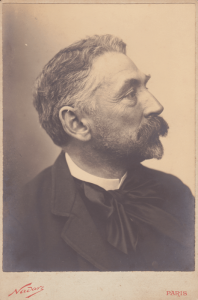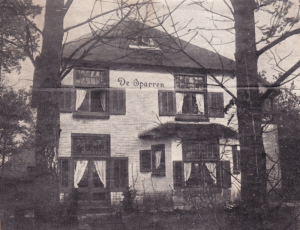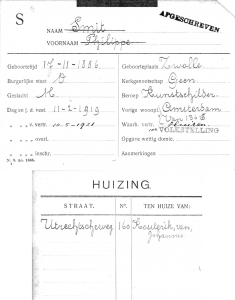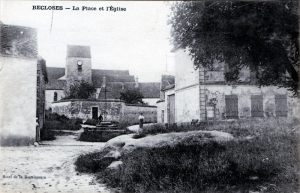Chronology 1914-1920: The Dutch refuge
1914
Beginning of the year: Smit is in France.
End of April: His exact whereabouts are unknown but it is most likely that he stays in Holland from this time until the end of the Great War.
Hopes for a visit from the Massés. Without money, he cannot plan a trip to Paris “because life for [him] is difficult when one does not have a penny.” He “paints some big pastels“, walks in the footsteps of Claude Monet1 and is “very very curious to see [the exhibition of Odilan Redon in Haarlem2 because [he] likes him very much.“3
He is often welcomed – and for long periods of time – by the Urbans “[…] I lead a princely life with my friends. They are extraordinarily good to me and yet I miss the country [France]. Oh, in terms of painting, I am not lucky. Nothing works for me. I have not managed to sell a single study. It’s terrible, so of course I am in a bind, as they say. I have to wait, because if I have no money, I can’t do anything, I cannot go back to Paris either […] I had often imagined a beautiful spring with the money I would have earned from my pastels – and nothing, nobody here in Holland wants my things. So what to do […]“.4
13 April: doesn’t succeed in his exhibition project “because the frames are very expensive and all in all, it is an awful lot of money for these pastels“; he goes back to Van Daalhofff’s with the Urbans, “think[s] so often of Millet when spring arrives, all the trees in blossom” and asks his friend Massé to send him the book about Millet from the collection L’art De Notre Temps5.6
9 November: “[…] I have been painting a series a pastels lately, the portrait of my sister [unidentified], of which a photo is enclosed and other pastels: the girl [PS 84 ?] and the little boy [PS 103 ?] of friends […]“; he is fascinated by Van Gogh; reads his letters which are “as good in Dutch as in French and full of small sketches of his first paintings “; “recently read Charles Blanchard, by Charles Louis Philippe“; is worried by the war and finds his sole hope in art.7
27 November: writes to Massé about his turmoil at the difficulty of painting and at the deaths of artists because of the war; he continues to read the last letters of Van Gogh and “seek[s] a little more to paint figures” and “enclose[s in the letter] two skteches of the little boy and the other of an old friend, who posed, still pastel because it is less expensive.“; he is worried that the colours and pastels with which “[he] started the Harvest and the bouquet [two unidentified works]” will not be sufficient but still considers himself “lucky that he can do something because if [he] had not [his] friends, he would not know what would become of him.“8
1. Claude Monet stayed four months in Zaandam in 1871 and went back to the Netherlands in 1886. 2. Kunstzaal De Bois, June-August 1941 ?. 3. PS, ALS to the Massés, [1914], Massé album, p. [28]. 4. PS, ALS to the Massés, [1914], Massé album, p. [27]. 5. Cain, Julien and Leprieur, Paul, Millet: 48 planches hors-texte, accompagnées de quarante-huit notices…, collection: L’art de notre temps, Paris: Librairie Centrale des Beaux-Arts, [1913]. 6. PS, ALS to the Massé, Hilversum, [13 April 1914], Massé album, p. [29]. 7. Philippe Smit 1914. 8. PS, ALS to the Massés, Hilversum, [27 November 1914], Massé album, p. [31].
1915
Misses Paris and his friends there; he deepens his knowledge of French writers and poets, who start having an influence on his works: “I will do my best to get a series of photos of the paintings I am doing here, [?] I would be very curious to have your opinion on this because I have changed a lot lately, I have read a lot of Octave Mirbeau (Farce and moralities [Farces and morality plays]) and Maupassant, and Renan and especially the poets [?] Tristan Corbière, it is magnificent it is poetry / carved in the rocks. Paul Fort, Maeterlinck, Rimbaud Verlaine, Mallarmé etc. […]“.1 (fig. 1)
January: is delighted to inform the Massés that the Urbans are going to move to a house with a very large studio overlooking a park in Amsterdam, and that he hopes to work there more and is looking forward to the city and the museums while at the same time remaining very attached to nature, which for him in these grave periods “has something consolatory“; he continues his readings of contemporary French poets.2 & 3
16 June: still erroneously domiciled in Paris he is, from this day on, officially registered with the annotation of a “temporary stay” at the Urbans address in Amsterdam.
1. PS, ALS to Massé, Arnhem, [6 November 1915], Massé album, p. [32]. 2. PS, ALS to the Massés, [January 1915 (erroneously dated 1916 by Massé], Massé album, p. [32]. 3. Coming from Hilversum the Urbans move to Amsterdam (Oosterpark 89) in February 1915 where they stay until 4 January 1917.
1916
1–30 April: exhibits 58 paintings and pastels in Amsterdam (fig. 2);1 complains that he is misunderstood by the critics. “[…] I am currently exhibiting my paintings and pastels, and if you knew how stupid the critics are, all the nonsense that I have heard, no, you have no idea, I enclose a catalog of the exhibition, the reproductions are not extraordinary and there are not many, but well, it will give you an idea of what I am trying to do […]“.2
1. 1916 Larensche Kunsthandel. 2. PS, ALS to the Massés, [April 1916], Massé album, p. [32].
1917
6 November: writes to his father and talks about his latest completed works1 and shares his thoughts with him on painters and musicians in response to an article about Degas that his father sent: “[…] I don’t like Degas at all […] he is a skilful painter but he is not a painter of the soul […] he is a juggler, nothing more. But when I think about Vincent van Gogh or El Greco, oh, these are for me such great Masters […] Cézanne very beautiful colours, a great creator of form and colour but alas not a soul searcher[…] there is just the one, in music, the great Claude Debussy. His Art moves me to the very depths of myself. What a genius César Franck […]“.2
1. See [PS 176] and [PS 174]. 2. Philippe Smit 1917.
1918
22 May: worried about the Massés and about the situation in Paris, he is submerged in deep melancholy, regrets very much not being able to share his thoughts on art and describes to them the things he likes and which are around him in Laren, expresses his admiration for El Greco, “the irate painter of Toledo”, Seurat, Vuillard, Rodin and Monet.1
5 November: the sudden death of Smit’s sister Emma, with whom he was very close and whom he represented in several paintings.
20 November: Smit is happy about the end of the war and that Alsace and Lorraine are French again, hopes to see the Massés in Holland, is looking for his father from whom her has not heard since April, laments that art “has fallen into stagnant agony” and believes “that even in Paris there are very few people who understand [him], [but] understanding is still nothing, because art is a mystery that one should not seek to reason.“2
1. See PS, ALS to the Massés, Laren, 22 May 1918, Massé album, p. [34]. 2. PS, ALS to the Massés, Laren, 20 November 1918, Massé album, p. [34]
1919
Smit remains in Holland with the Urban family in Laren/Blaricum1 where a studio is built for him (fig. 3 & 4), but starts organising trips to Paris.
January: asks his father to find money to bring his paintings back to Paris and to find a studio in which to store them and to obtain information from Signac about “an exhibition of Independent Artists“.2
11 February: stays from now on with Johannes van Kouterik à Hilversum, Utrechts(ch)eweg 160.3
20 April: is “painting a big chest” [PS 220 ?] and talks about an exhibition project in the new studio of René Massé.4
31 July: letter from Holland: impatiently waiting for the visit of René Massé and his father in Laren, arrival planned for 16 August; express his veneration for French art and that the war years “in Holland have been a silent labour for France“; talks for the first time about his friend and critique Anton Zelling, who owns a vast collection of music by Claude Debussy.5
October: works on his Pietà [PS 189], would like to hear about the Salon d’automne and its artists such as Rodin, Vuillard, Marquet, Picasso6; thinks about registration for the Salon de la Société des Artistes Indépendants.7
18 December: regrets that Massé cannot come to Laren for Christmas and asks him to ship three of his works, Bouquet of poppies (not identified), The Harvesters [PS 83 ?] and the Birch Trees in Autumn [PS 92], so he can give them to the Urbans.8
1. In January 1917 the Urbans leave Amsterdam in order to move to Villa “de Sparren”, Achter de Torenlaan, Blaricum, a village bordering Laren. Though from the administrative point of view they are registered in Blaricum their social and cultural life is in Laren. The Urbans and the painter always talk about this town where even their correspondence was addressed to. 2. See Jacobus Smit, ALS to Massé, Paris, 14 January 1919, Massé album, p. [35]. 3. Apart from the registration form (record of domestic servants) (fig. 6) we have no information neither on the identity of J. van Kouterik nor on the reason and the length of this stay in Hilversum. This very form mentions that he was in Huizen when the census was done on 10 May 1921. In absence of other evidences we think that this is due to a mere confusion with the adjacent village Blaricum where he lives officially with the Urbans from 4 April 1921 on. 4. Note from PS added to an ALS from Nicolaas Urban to Massé in which Urban asks not to inform Smit’s father of the death of Emma, Laren, 20 April 1919, Massé album, p. [35]. 5. See PS, ALS to the Massés, Laren, 31 July 1919, Massé album, p. [36]. 6. See Philippe Smit 1919b. 7. See Urban/Smit, ALS to Massé, Laren, [9 October 1919], Massé album, p. [37]. 8. See PS, ALS to Massé, Laren, 18 December 1919, Massé album, p. [38].
1920
Lives and works mostly in Laren until 1926, while often staying in the Fontainebleau area and Paris.
1 January: hopes to exhibit at the Salon de la Société des Artistes Indépendants.1
7 January: regrets very much that it is too late for the Indépendants and thinks of exhibiting at the Salon de la Société Nationale des Beaux-Arts;2 he asks René Massé to look into it; he is not in line with the contemporary production: “This is what I noticed when you sent me the Comœdia illustré that people like Matisse, Van Dongen, Vallotton, etc. are dominating. How sad, there is no one figure that can really give you an emotion of beauty and truth.“3
14 February: informs Massé about his stay in France, ships three paintings to Paris: Pietà [PS 189], Legend of a vagabond [PS 211] and Frère et soeur (Brother and Sister) [PS 174].4
23 February: René Massé: “[…] He went to see the sculptor [Paul-Albert] Bartholomé in order to be introduced to the Spanish painter [Ignacio] Zuloaga and look at the paintings by El Greco.”5
March: leaves rue Malte Brun to move into a maid’s room at 10 rue de la Pépinière in the 8e arrondissement.
10 March: René Massé: “[…] His visit to the painter Zuloaga, the Grecos. […]“.6
13 March: René Massé: “[…] chat about his stroll in Barbizon, has seen Millet’s grandson. His visit to the painter Lucien Simon, rich painter! Disappointed by his art, he is not a lover of Brittany; he is ignorant of its Legends.“7
17 March: René Massé: “[…] He is refused exhibition at the Salon de la Société Nationale des Beaux-Arts. His visit to Henri Rivière, charming man. His visit to Felix Fénéon .”8
21 March: René Massé: “[…] His visit to Vuillard […] Vuillard should go to the Nationale to see his works. ꞌPiétaꞌ [PS 189]. ꞌPortraits of Smit and of his sister Emmaꞌ [PS 174]. ꞌThe Vagabond’s Legendꞌ [PS 211]. Vuillard should give him a letter of introduction to Claude Monet in Giverny.”9
24 March: René Massé: “[…] Vuillard, at the Nationale, has seen Philippe’s paintings. His non-understanding, finds it caricatural, his going astray.“10
10 April: René Massé: “[…] His visit to the painter Picasso rue de la Boétie. His first period – his current work!! back to his first period.“11
Before Pentecost: pays a visit with the Urbans and Anton Zelling to the Camondo and Moreau-Nelaton collections, as well as to the hôtel Biron; he stays four days in Barbizon and Recloses; would like to exhibit with René Massé at the Salon d’Automne12.13
24 April: gives an account of his short trip to France with the Urbans: “[…] you have no idea how happy they were in Recloses […] we are all crazy about Recloses, Nico will do his best to go live there […]” and talks about Picasso’s visit: “[…] Imagine this, before going [to the Netherlands] we have had a visit from Picasso, he was very charming, and he asked us above all not to forget him and maybe he will come to Holland, he felt a bit strange in front of my paintings but he likes the Piéta […]“.14
24 July: ponders questions about art, its principles and styles, he “[does] not try to make a style“, defending his approach based on a quest to bring emotion, “if [it] is mature and thought out with all the faith that you have for art, you ought to achieve the divine work“, without forgetting painting, he “believe[s] that no one is more sensitive than [he] to colour and form“; deplores the fashion to create “the latest things” and his time “filled with formula, principle and all that accompanies it” and invites Massé to critique his works.15
31 August: Notifies Massé about his short trip to Paris and that he has abandoned the idea of exhibiting at the Salon d’Automne: “We are so happy to be able to go to Paris for a few days […] our dear friend Jean [Jan Zondag] is coming as well as our dear and big Marijke […] as for myself, I am extremly happy as I am exhausted after working so much lately. And for the salon d’Automne I don’t think I will exhibit, because what for in the end? … success and all these things leave me so deeply indifferent. The only thing would be to be able to sell easily […] I can’t wait to see museums.[…]“.16
9 September: René Massé: “Mr and Mrs Urban, Philippe were received by the painter Claude Monet in Giverny. They didn’t arrive before 23:30 […]“.17
15 September: René Massé: “Departure of the Urban family to Amsterdam, as well as Philippe (Gare du Nord) […]“.18
3-11 October: exhibits at the Sparren studio in Laren;19 sells five works.20
November: returns to Paris and stays there until 7 December.
10 and 27 November: René Massé: “[…] he gave us a pastel as a souvenir of ꞌSparrenꞌ” and “[…] he signed the pastel ꞌSparrenꞌ that he gave as a souvenir of my stay in Holland.“21
23 November: stays at the Renaissance hotel in Recloses (fig. 6) and asks Massé to send him some materials to protect the pastels he has made there.22
End of the year: returns to the Netherlands (departure on 7 December23).
1. 31th exhibition, 28 January – 29 February (see Philippe Smit 1920a). 2. 14 April – 30 June (see Philippe Smit 1920b). 3. Ibid. 4. See PS, ALS to the Massés, [14 February 1920], Massé album p. [41]. 5. Massé 1920-1935, p. [1], see [PS 210]. 6. Ibid., p. [2]. 7. Ibid. 8. Ibid. 9. Ibid. 10. Ibid., p.[3]. 11. Ibid. 12. 15 October – 12 December 1920. 13. See PS, ALS to Massé, [before Pentecost 1920], Massé album p.[42]. 14. PS, APCS to Massé, Amsterdam, [24 April 1920], Massé album p.[40]. 15. See Philippe Smit 1920c. 16. PS, ALS to René Massé, Sparren, [31 August 1920], Massé album, p. [42]. 17. Massé 1920-1935, p. [4]. 18. Ibid. 19. 1920 Sparren. 20. See Massé 1920-1935, 9 November 1920, p. [4]. 21. Ibid. p. [4] et [5]. 22. See PS, PCS aux Massé, Recloses, [23 November 1920], Massé album, p. [43]. 23. See Massé 1920-1935, 7 December 1920, p. [5].





